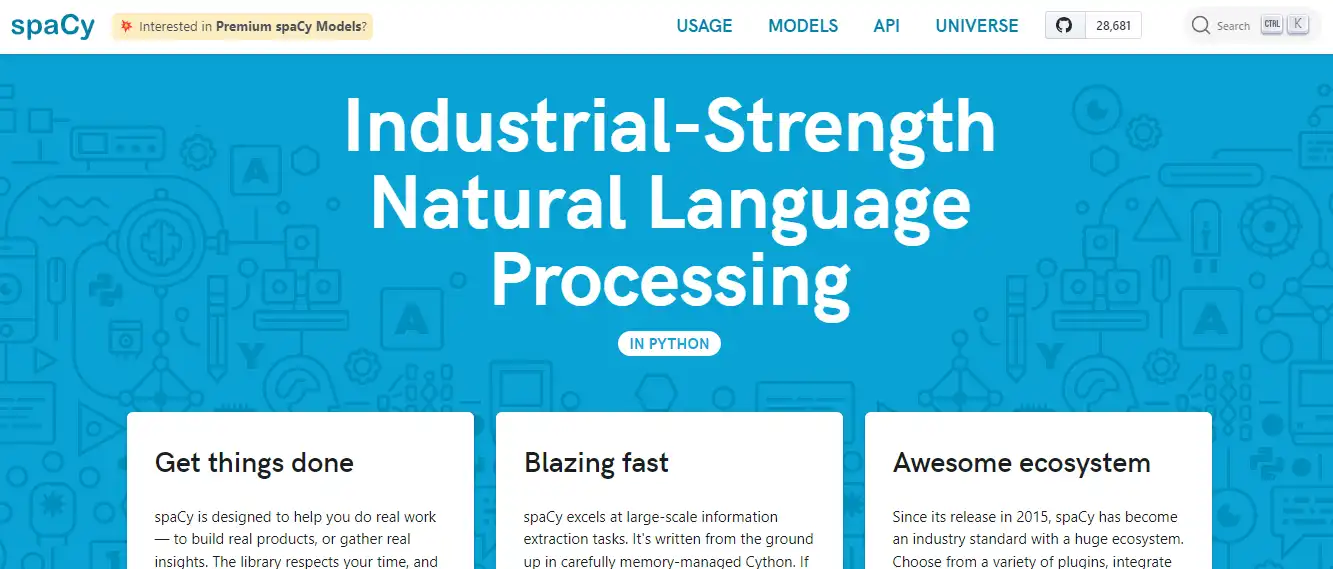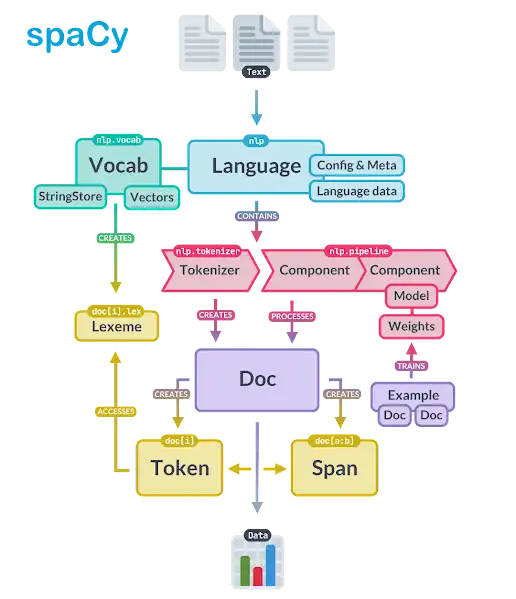Introduction
Natural language processing (NLP) has exploded in recent years, revolutionizing everything from search algorithms to chatbot development. By enabling machines to parse, analyze and generate human speech, NLP unlocks game-changing AI capabilities.
Markets predict nearly $70 billion in global natural language AI spending annually by 2027 according to Reports and Data. Yet specialized libraries and frameworks remain the key to unlocking NLP’s immense potential - which is where SpaCy soars ahead of alternatives.
The secrets lie in its industrial-strength feature sets for part-of-speech tagging, named entity recognition, text classification and beyond - handling jobs in minutes that previously required months of complex coding.
Whether you are looking to elevate search relevancy, analyze user feedback more intelligently or automate document processing, SpaCy delivers the bleeding-edge NLP capabilities today’s data scientists demand.
Let’s explore SpaCy fundamentals for utilizing natural language AI across business domains.
Getting Started with Spacy

Spacy is a powerful NLP library that provides a simple, user-friendly interface for working with text data. In this section, we will guide you through the process of downloading and installing Spacy, as well as setting up a virtual environment to work with Spacy.
Downloading and Installing Spacy
The first step to getting started with Spacy is to download and install it on your system. Here are the steps to do so:
- Open the command prompt or terminal and enter the command pip install spacy
- This will automatically download and install the latest version of Spacy on your system
- You can check whether Spacy has been installed correctly by entering the command spacy info. This will display all the relevant information about the installation, such as the version number and the available models.
Once you have installed Spacy on your system, you can start working with it.
Setting up a Virtual Environment for Spacy
A virtual environment is a self-contained environment that allows you to install Python packages without affecting the global Python environment on your system. Here are the steps to set up a virtual environment for Spacy:
- Open the command prompt or terminal and create a new directory for your virtual environment. You can do this by entering the command mkdir myenv
- Navigate to the newly created directory by entering the command cd myenv
- Create a new virtual environment by entering the command python -m venv venv
- Activate the virtual environment by entering the command source venv/bin/activate
Congratulations! You have now set up a virtual environment for Spacy.
Working with Text Data in Spacy

In this section, we will show you how to work with text data in Spacy. Specifically, we will cover how to load text data into Spacy from various sources such as files and web pages.
Loading Text Data
Before we can work with text data in Spacy, we need to load it into the library. Here are the steps to do so:
Reading Text from Files
- Create a new Python file in your virtual environment and import the Spacy library by typing import spacy
- Load the text file by assigning it to a variable using the following code:
with open("filename.txt", "r") as f: text = f.read() - Load the Spacy model by typing nlp = spacy.load("en_core_web_sm")
- Apply the model to the text by typing doc = nlp(text)
Loading Text from a Web Page
- Import the Spacy and requests libraries by typing import spacy and import requests respectively
- Send a request to the web page by typing response = requests.get("https://www.example.com")
- Load the HTML content of the web page by typing html = response.content
- Use the Beautiful Soup library to extract the text content from the HTML by typing:
from bs4 import BeautifulSoupsoup = BeautifulSoup(html, "html.parser")text = soup.get_text() - Load the Spacy model by typing nlp = spacy.load("en_core_web_sm")
- Apply the model to the text by typing doc = nlp(text)
Suggested Reading:
Exploring Chatbot Frameworks that Integrate Well with spaCy
Advanced Text Processing with Spacy
Spacy provides advanced text processing capabilities that allow you to customize the Spacy model, as well as analyze text in various ways. In this section, we will explore how to customize the Spacy model and perform sentiment analysis on text using Spacy.
Customizing the Spacy Model

Spacy is a powerful library for natural language processing that provides a range of functionalities out of the box. However, it also allows for customization to meet specific requirements. In this section, we will explore two ways of customizing the Spacy model.
Adding Custom Entities
One of the key features of Spacy is its ability to recognize and categorize named entities. However, the default model may not always cover all the entities relevant to a specific application. In such cases, we can extend the Spacy model to include custom entities.
By training a custom entity recognizer, we can teach Spacy to identify domain-specific entities that are not covered by the default model. This involves providing labeled training data and using it to train a new entity recognizer. Spacy provides a simple interface for this process, making it easy to add custom entities to the model and enhance its performance.
Suggested Reading:
Crafting Chatbots Using Spacy NLP
Fine-Tuning the Part-of-Speech Tagger
Spacy's part-of-speech tagger assigns grammatical labels to words in a text. While the default Spacy model performs well in many cases, there may be situations where it fails to assign accurate tags. Fortunately, we can fine-tune the part-of-speech tagger to improve its accuracy in specific contexts.
To fine-tune the tagger, we need annotated training data that includes both the text and the correct part-of-speech tags. By training the tagger on this data, we can improve its performance in situations where the default model struggles. This allows us to tailor the Spacy model to better suit our specific text processing needs.
Taking your first step towards chatbot isn't that tough. Meet BotPenguin- the home of chatbot solutions. With all the heavy work of chatbot development already done for you, deploy chatbots for multiple platforms:
- WhatsApp Chatbot
- Facebook Chatbot
- Wordpress Chatbot
- Telegram Chatbot
- Website Chatbot
- Squarespace Chatbot
- Woocommerce Chatbot
- Instagram Chatbot
Analyzing Text with Spacy
Spacy provides a range of capabilities for analyzing text, including sentiment analysis. Sentiment analysis involves determining the sentiment expressed in a piece of text, such as whether it is positive, negative, or neutral. This can be useful in various applications, such as social media monitoring or customer feedback analysis.
Performing Sentiment Analysis on Text

To perform sentiment analysis with Spacy, we first need a labeled dataset that associates specific text with corresponding sentiment labels. This dataset is then used to train a sentiment analysis model using Spacy.
Once the model is trained, we can use it to analyze new text and obtain sentiment scores. These scores indicate the level of positive or negative sentiment expressed in the text. By processing large volumes of text, we can gain valuable insights into public opinions, customer sentiments, and more.
Interpreting Sentiment Analysis Results
After obtaining sentiment scores from the Spacy model, the next step is interpretation. Analyzing sentiment goes beyond just positive and negative scores. We must consider the context of the text and understand the nuances of sentiment expressed.
For example, a high positive sentiment score may not always indicate complete satisfaction. It could be sarcasm or an exaggeration. Similarly, a slightly negative score may not necessarily mean strong dissatisfaction. Interpreting sentiment analysis results requires a contextual understanding of the text and the specific domain in which it is used.
In summary, Spacy provides advanced text processing capabilities that can be customized to include custom entities and fine-tune part-of-speech tagging. Additionally, Spacy allows for sentiment analysis, which involves training a model and interpreting sentiment scores. These features make Spacy a powerful tool for analyzing and understanding text data.
Conclusion
As we have explored through several practical examples, SpaCy delivers an incredibly versatile natural language processing toolkit for everything from basic text analysis to production-scale document processing pipelines. Its balance of approachable API design, pre-trained out-of-the-box statistical models, and industrial-strength capabilities creates a gateway for Python developers at any skill level to start benefiting from advanced NLP techniques.
Whether tailoring named entity recognition to your specialized domains or leveraging word vectors for contextual analysis, SpaCy modular design empowers tackling more ambitious use cases through Python scripting. Seamless GPU and TPU support also enable scaling up to tackle big data workloads as your NLP initiatives mature.
So whether you are just beginning your NLP journey or a seasoned practitioner, SpaCy delivers an agile launchpad for trailblazing innovation. Let your ideas take flight today by incorporating SpaCy into your Python data science stack. The cutting edge of conversational AI awaits!
Suggested Reading:
How to use Spacy for Text Analysis?
Frequently Asked Questions (FAQs)
What is Spacy and its significance in Natural Language Processing (NLP)?
Spacy is an open-source NLP library known for its speed, efficiency, and ease of use, offering tools for tasks like tokenization, part-of-speech tagging, and entity recognition.
What are the core features and functionalities of Spacy for text analysis?
Spacy offers features like named entity recognition, dependency parsing, tokenization, and lemmatization, empowering users for diverse text analysis tasks.
Can Spacy be integrated with Python programming?
Yes, Spacy seamlessly integrates with Python, providing a user-friendly interface and extensive documentation for easy integration.
Are there tutorials or resources available for beginners to learn Spacy?
Yes, numerous tutorials, documentation, and beginner-friendly resources are accessible to learn Spacy's functionalities step by step.
Does Spacy offer support for different languages apart from English?
Spacy supports multiple languages, providing models and functionalities for various languages, making it versatile for international users.
What are some practical applications or use cases of Spacy in NLP?
Spacy finds applications in sentiment analysis, information extraction, chatbots, document classification, and other NLP-related tasks.


